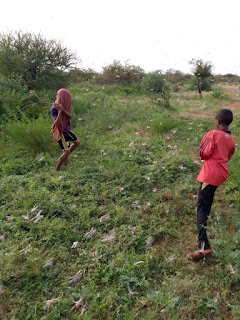Swarms of locusts invade Northeast of Kenya
Swarms of locusts have invaded Northeast of Kenya and are threatening food security in the region. The invasion comes barely a week after the Food and Agriculture Organization(FAO) sounded a warning over the same.
FAO warned that after the locust invasion in Somalia and Ethiopia, the swarms would move South towards Northeast Kenya and adjacent areas of Southern Somalia. New immature swarms are expected to start forming in the Ogaden by the end of this month that could threaten crops. However, as good rains fell over a large portion of the Ogaden and Somalia from Cyclone Pawan, many swarms are expected to remain in place, mature and lay eggs from late January onwards for another generation of breeding that would cause a substantial and dramatic increase in locusts, said FAO.
According to FAO, the locusts have damaged about 70,000 hectares of land in Somalia and neighboring Ethiopia, threatening food supplies in both countries and the livelihoods of farming communities. An average swarm will destroy crops that could feed 2,500 people for a year, FAO said.
FAO further says that efforts are required by the government to undertake surveys, timely reporting and efficient control, and to upscale these activities in the coming weeks and months to avert more destruction.
Swarms of locusts have invaded Northeast of Kenya and are threatening food security in the region. The invasion comes barely a week after the Food and Agriculture Organization(FAO) sounded a warning over the same.
FAO warned that after the locust invasion in Somalia and Ethiopia, the swarms would move South towards Northeast Kenya and adjacent areas of Southern Somalia. New immature swarms are expected to start forming in the Ogaden by the end of this month that could threaten crops. However, as good rains fell over a large portion of the Ogaden and Somalia from Cyclone Pawan, many swarms are expected to remain in place, mature and lay eggs from late January onwards for another generation of breeding that would cause a substantial and dramatic increase in locusts, said FAO.
 |
| Pic courtesy |
According to FAO, the locusts have damaged about 70,000 hectares of land in Somalia and neighboring Ethiopia, threatening food supplies in both countries and the livelihoods of farming communities. An average swarm will destroy crops that could feed 2,500 people for a year, FAO said.
FAO further says that efforts are required by the government to undertake surveys, timely reporting and efficient control, and to upscale these activities in the coming weeks and months to avert more destruction.


Comments
Post a Comment